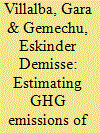| Srl | Item |
| 1 |
ID:
103403


|
|
|
|
|
| Publication |
2011.
|
| Summary/Abstract |
In recent years, GHG inventories of cities have expanded to include extra-boundary activities that form part of the city's urban metabolism and economy. This paper centers on estimating the emissions due to seaports, in such a way that they can be included as part of the city's inventory or be used by the port itself to monitor their policy and technology improvements for mitigating climate change. We propose the indicators GHG emissions per ton of cargo handled or per passenger and emissions per value of cargo handled as practical measures for policy making and emission prevention measures to be monitored over time. Adapting existing methodologies to the Port of Barcelona, we calculated a total of 331,390 tons of GHG emissions (CO2 equivalents) for the year of 2008, half of which were attributed to vessel movement (sea-based emissions) and the other half to port, land related activities (land-based emissions). The highest polluters were auto carriers with 6 kg of GHG emissions per ton of cargo handled. Knowing the highest emitters, the port can take action to improve the ship's activities within the port limits, such as maneuvering and hotelling. With these results, the port and the city can also find ways to reduce the land-based emissions.
|
|
|
|
|
|
|
|
|
|
|
|
|
|
|
|
| 2 |
ID:
125847


|
|
|
|
|
| Publication |
2013.
|
| Summary/Abstract |
Like cities, many large national parks in the United States often include "urban" visitor and residential areas that mostly demand (rather than produce) energy and key urban materials. The U.S. National Park Service has committed to quantifying and reducing scopes 1 and 2 emissions by 35% and scope 3 emissions by 10% by 2020 for all parks. Current inventories however do not provide the specificity or granularity to evaluate solutions that address fundamental inefficiencies in these inventories. By quantifying and comparing the importance of different inventory sectors as well as upstream and downstream emissions in Yosemite National Park (YNP), this carbon footprint provides a case study and potential template for quantifying future emissions reductions, and for evaluating tradeoffs between them. Results indicate that visitor-related emissions comprise the largest fraction of the Yosemite carbon footprint, and that increases in annual visitation (3.43-3.90 million) coincide with and likely drive interannual increases in the magnitude of Yosemite's extended inventory (126,000-130,000 t CO2e). Given this, it is recommended that "per visitor" efficiency be used as a metric to track progress. In this respect, YNP has annually decreased kilograms of GHG emissions per visitor from 36.58 (2008) to 32.90 (2011). We discuss opportunities for reducing this measure further.
|
|
|
|
|
|
|
|
|
|
|
|
|
|
|
|